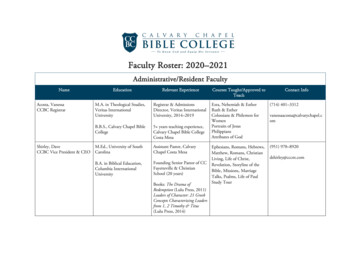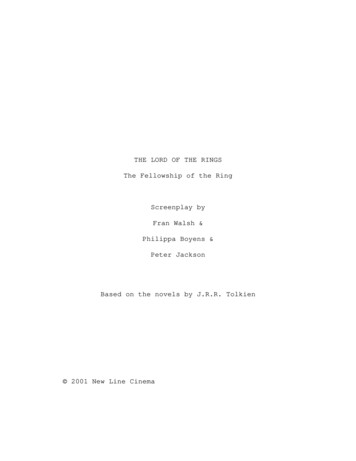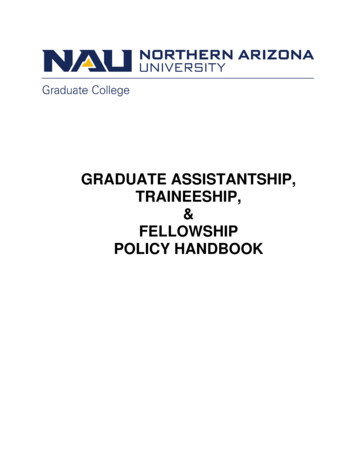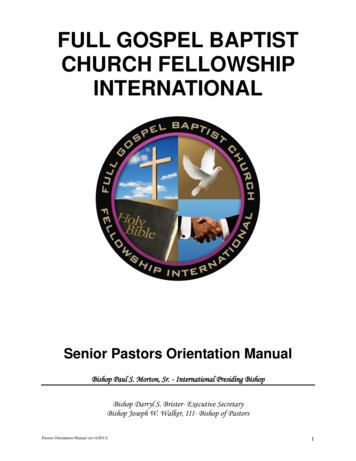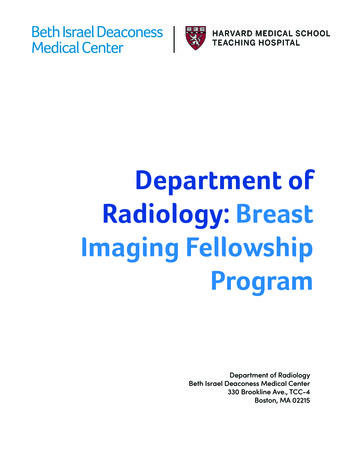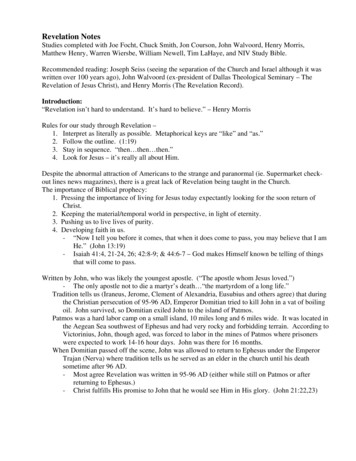
Transcription
Revelation NotesStudies completed with Joe Focht, Chuck Smith, Jon Courson, John Walvoord, Henry Morris,Matthew Henry, Warren Wiersbe, William Newell, Tim LaHaye, and NIV Study Bible.Recommended reading: Joseph Seiss (seeing the separation of the Church and Israel although it waswritten over 100 years ago), John Walvoord (ex-president of Dallas Theological Seminary – TheRevelation of Jesus Christ), and Henry Morris (The Revelation Record).Introduction:“Revelation isn’t hard to understand. It’s hard to believe.” – Henry MorrisRules for our study through Revelation –1. Interpret as literally as possible. Metaphorical keys are “like” and “as.”2. Follow the outline. (1:19)3. Stay in sequence. “then then then.”4. Look for Jesus – it’s really all about Him.Despite the abnormal attraction of Americans to the strange and paranormal (ie. Supermarket checkout lines news magazines), there is a great lack of Revelation being taught in the Church.The importance of Biblical prophecy:1. Pressing the importance of living for Jesus today expectantly looking for the soon return ofChrist.2. Keeping the material/temporal world in perspective, in light of eternity.3. Pushing us to live lives of purity.4. Developing faith in us.- “Now I tell you before it comes, that when it does come to pass, you may believe that I amHe.” (John 13:19)- Isaiah 41:4, 21-24, 26; 42:8-9; & 44:6-7 – God makes Himself known be telling of thingsthat will come to pass.Written by John, who was likely the youngest apostle. (“The apostle whom Jesus loved.”)- The only apostle not to die a martyr’s death “the martyrdom of a long life.”Tradition tells us (Iraneus, Jerome, Clement of Alexandria, Eusubius and others agree) that duringthe Christian persecution of 95-96 AD, Emperor Domitian tried to kill John in a vat of boilingoil. John survived, so Domitian exiled John to the island of Patmos.Patmos was a hard labor camp on a small island, 10 miles long and 6 miles wide. It was located inthe Aegean Sea southwest of Ephesus and had very rocky and forbidding terrain. According toVictorinius, John, though aged, was forced to labor in the mines of Patmos where prisonerswere expected to work 14-16 hour days. John was there for 16 months.When Domitian passed off the scene, John was allowed to return to Ephesus under the EmperorTrajan (Nerva) where tradition tells us he served as an elder in the church until his deathsometime after 96 AD.- Most agree Revelation was written in 95-96 AD (either while still on Patmos or afterreturning to Ephesus.)- Christ fulfills His promise to John that he would see Him in His glory. (John 21:22,23)
The importance of the OT in Revelation:- Daniel is quoted 53x.- Psalms are quoted 43x.- Zechariah is quoted 15x.- Ezekiel is quoted 42x.- Isaiah is quoted 79x.- Exodus is quoted 27x.- Jeremiah is quoted 22x.- Of the 404 verses in Revelation, 265 verses allude to 550 OT verses. The prophecies of theOT reach their conclusion in Revelation. (Info quoted from a Greek Study Bible.)Henry Morris’ outline: Ch. 1-3 – The Church Age – of unknown, yet finite, duration.Ch. 4-19 – Period of Judgment – 7 years.Ch. 20 – Kingdom Age – 1,000 years.Ch. 21-22 – Eternal Age – Endless years.Chapter 1:1:1 – “Revelation of Jesus Christ” – The purpose of this book, and the Scriptures on the whole (John5:39), is to reveal Jesus to us. The prophecy and predictions are secondary and given to revealChrist as He relates to the future events, His enemies, His Church, and us personally.- “revelation” – (Greek “apokalypso”) Lit. “unveiling.” The wraps are being pulled off Jesus.- The Greek word “apokalypsis” appears in various forms at least 18 times in the NT (ie. 1Cor. 2:10).- The last physical description of Jesus is in Acts 1, as Jesus lifts off in the clouds. Yet,Jesus and His kingdom all find their fulfillment in Revelation.- “Jesus Christ” – More titles given to Jesus in Revelation than in the rest of the entire NT – atleast 4 titles in Ch. 1 alone.o “King of kings” – Rev. 19:16; (“king” – 4 times in Revelation.)- King of Kings is the supreme title of Jesus. (Of the 95 Greek manuscripts thatare used to compile our translation for Revelation, all of them contain 19:16.)o “Lamb of God” – 25 times in 22 chapters.- King of kings and Lamb of God, Coming King and Suffering Servant, Lord andSavior – we need both! If we only know Jesus as the King w/o also being theLamb, we have an all-powerful dictator that cannot be touched with ourinfirmities. And like the Pharisees, we have a God that produces no change inour lives. If He was only the King, He wouldn’t be able to relate to us; Hewouldn’t have any impact on our lives. (Presidents example )- If we only know Jesus as the Lamb, w/o also accepting His Kingly nature, wehave an impotent God who can relate but can’t help. It is the all-loving, allaccepting, all-embracing God of the New Age seeing Jesus as a great teacher,guru, spiritual guide, or ascended master.- “to show” – The purpose of the revelation. This book is to be known and understood. There is acommon misconception concerning the book of Revelation. A lot of people think of it as asealed book. It is exactly the opposite. It is allowing us to see what the future holds as far asJesus Christ is concerned. (Rev. 22:10)- Most of the controversy and confusion over the Bible is over Genesis and Revelation.Genesis is where Satan receives his judgment. Revelation is where the sentence on Satan isexecuted.- “servants” – Lit. “bond-slaves.” This is all of us – servants are plural.2
- “shortly” – (Greek “en taxia”) Lit. “in quick succession.” Doesn’t speak of soon-ness, but ofshort-ness or brevity. Once it starts, it will come to conclusion in quick succession.- The word is also used in Rom. 16:20; Luke 18:8, and Rev. 22:6.- The NT speaks of “sorrows,” “birth pains,” and “as a woman in travail” – looking at thesigns of the times increasing with frequency and intensity.- Jesus said that if He wouldn’t return when He does, there would be no flesh left alive. (Mt.24:22)- Unless we reject utterly the idea that this part (ch. 5-22) of the Revelation has been“gradually fulfilling itself” in this present age, we shall miss the meaning of the book.Remember Paul’s explanation of the doctrine of the Jewish remnant in Rom. 9:27-28, “TheLord will execute His word upon the earth, finishing it and cutting it short.” The presentdispensation must not in any sense be confused with God’s future dealing with the Jewishremnant after the true Church has been taken to heaven.- “signified” – Lit. “given in signs.” The angel relates Revelation to John in signs and wordpictures. It means nothing to the unregenerate mind, but reveals truths to the heart of everybeliever.- “angel” – Lit. “messenger;” most often a heavenly messenger. (The word “angel” is used 74x inthis book.)- 17x we will go back-and-forth from earth to heaven- 44 separate visions- 22x - “like” of “likeness” is used- 65x – “as” is used- 60x – “I saw” is used- 30x – “behold” (meaning “consider’)- 84x – “great” is used- 54x – the number “seven” is used- Over 300 references to the OT- “John” – Identified as the author 4 times in Revelation (1:1, 4, 9; 22:8)1:2 – “witness” – “testimony” – Both from the root for “martyr.” A martyr is one who is willing to diefor the cause of Christ, whether or not they actually die. (Acts 1:8 – witness is something youare, not something you do.)1:3 – “Blessed” – The only book promising such blessing, making this book unique.- There are 7 blessed/beatitudes in Revelation.- “reads” –Singular, present tense (“he” – public context).- “hears” – Plural, present tense (“they” – public context).- “keep” – Present tense (lit. “to keep at it, to keep in it, to keep after it”).- The primary sense of the word is “watching over, or guarding as a treasure.” Its secondarysense is also “to give heed to.” The prophecy will be fulfilled, whether we pay attention toit or not. But there is divine blessing if we give heed to it and jealously guard its verywords.- “prophecy” – Of the 4 interpretive views on Revelation (Preterist – Church’s struggle withRome, Historical – Church’s struggle with the world, Allegorical – strictly spiritual with nodirect application, and Futurist – straightforward prophecy) only Futurist is directlysupported by the text. (v. 1 & 3)- Prophecy is crucial to understanding the Bible – portions of Genesis, Psalms, Daniel,Isaiah, Ezekiel, Zechariah, 1 Thessalonians 5, Matthew 24, Mark 13, and Luke 21 are3
prophetic (totaling 8,362 verses in the Bible.) Over 1 in 10 verses in NT areprophecy.- 1 Cor. 2:9-10 – “eye has not seen but the Spirit reveals (or unveils) it.”“time is near” – The time for Jesus to be revealed. (We are 2,000 years closer to Christ’s returnthan when John wrote the book.)- If we really believe that, it will effect out lives. Believers will live in purity, be busyabout His business, and have eternity in view. Unbelievers must ask themselves “howlong can it go like this?”- We cannot truly believe that Jesus’ return is imminent if we believe something musthappen before Christ returns.- Rev. 21 – “wipe every tear from our eyes.” We would’ve never thought that up on ourown concerning Almighty God. He has to reveal it to us. One day is will be very clear– “as lightening flashes from the east to the west;” the King will return. But today Heis revealing Himself in our hearts – as the Lamb of God to take away the sins of theworld.1:4 – “seven churches” – Who the letter was written to. (There were other churches in area.)- Seven gives us a complete picture of the church – even to (or in) our day.- Paul also wrote to 7 different churches.- “Asia” – Asia-Minor; around modern-day Turkey.- “grace and peace” – Always in that order.- It is “peace with God” and the “peace of God.” And this is in light of the ongoingpersecution of that time and the impending judgments laid out in Revelation.- John hears this greeting while exiled on the island of Patmos.- “is, was, and is to come” – From our perspective. God’s vantage point is “I am,” as He onlyexists in the present.- Makes justification, sanctification, and glorification possible at the same time.- We see Revelation come from both the present and eternal perspectives. (The concept ofpast, present, and future corresponds to the threefold chronological division of the bookitself in Rev. 1:19; 1:8; 4:8; 11:17; and 16:5.)- Two seemingly opposing concepts can actually agree when there is added moredimensions. For example, a cone in 2-dimensions looks like a circle from the top and atriangle from the side. But in 3-dimensions, the circle and triangle are both actually thecone.- “seven Spirits” – The Holy Spirit. The number seven denoting perfection and completeness.- Seven-fold Spirit – Isa. 11:2 (six attributes) and Zech. 4. Also in Rev. 4:5 and 5:6.- The order of the Father, Son and Spirit different than elsewhere in the Scriptures.- Grace and peace come from here too.1:5 – “faithful” – Dependable and true (unlike any ruler we’ve ever seen.)- “witness” – (Greek “martus”) Lit. “martyr.”- Jesus alone is the perfect manifestation of God; Jesus lets us know who God is. If we wantto know what God is, we can look at Jesus Christ and know exactly what God is.- “If you have seen Me (Jesus), you have seen the Father.” (John 14:9)- “firstborn” – (Greek “protocos”) Lit. “first of a new order.”- Speaks of Jesus being first in prominence, not first in time. (Against the Jehovah’sWitness’ claim that Jesus is a created being. See also 1 Cor. 15:20-23; Rev. 22:8-9; Rom.1; Ps. 89:27,37; Col. 1:15-18; Heb. 1:6; Rev. 1:8,11; and John 1:1.)4
-For an example of God calling a non-firstborn the firstborn according to preeminence, seeJer. 31:9 where God calls Ephraim His firstborn.- “from the dead” – (Greek “ecnecron”) Lit. “out from among the dead.”- “ruler of the kings” – (Greek “arcon”) This is not a democracy. God’s kingdom is an order.- The King we are looking for is not a president or a pope.- “loved us and washed us” – Lit. “keeps on loving us (present tense) and who has washed us(aorist tense) once for all.”1:6 – “kings” – Rev. 5:9-10 – “we shall reign.”- In kingdom age, Israel will serve Jesus as the Church rules and reigns with Him.- It is called a kingdom, because it is ruled by a King.1:7 – “Behold” – Lit. “consider this.”- Jesus’ soon and sure return should affect our behavior.- Revelation begins and ends with prediction of Jesus’ second coming (22:7,17,20).- “with clouds” – The Church (Heb. 12 – “great cloud of witness”), literal clouds (Dan. 7:13; Matt.24:30) or both. (Matt. 26:64)- “every eye shall see Him” – This means every eye – living and deceased. (Not just theJehovah’s Witnesses who say Jesus came privately in 1914 to a secret chamber in Brooklynand only those who have spiritual eyes can see Him, as He now reigns the world in theKingdom Age from His secret chamber.)- “they who pierced Him” – Referring to Israel. (Zech. 12:10; John 19:37)- The Bible prophesied of a pierced Messiah in Psalm 22:16; Isaiah 53:5, and Zech. 12:10.- “will mourn” – This is not in repentance, this is in fear.- Notice the contrast between the “grace and peace” of v. 4 with the “mourning” of v. 7.1:8 – Verse 8 contain the first words John hears from heaven in the giving of the Revelation.- “Almighty” – (Gr. “pantokrator”) Lit. “the One of all power.” (Parallel to the Hebrew “ElShaddai.”) There can only be one Almighty.- 9 of the 12 occurrences of this term in the NT are used in Revelation.- It is fitting here, in chapter 1, after the general announcement of our Lord’s coming, and ofthe general contents of the Revelation, that there should be a solemn seal upon all by Godas God.1:9 – “John your brother” – John is a brother, in the kingdom and in Christ, with us. The apostleJohn was the oldest living disciple of our Lord at the time of this writing, and yet heimmediately identified himself with the people.- “tribulation” – (Greek “tribulim”) The part of the threshing sled pulled over the grai
Revelation Notes Studies completed with Joe Focht, Chuck Smith, Jon Courson, John Walvoord, Henry Morris, Matthew Henry, Warren Wiersbe, William Newell, Tim LaHaye, and NIV Study Bible. Recommended reading: Joseph Seiss (seeing the separation of the Church and Israel although it was written over 100 years ago), John Walvoord (ex-president of Dallas Theological Seminary – The Revelation

